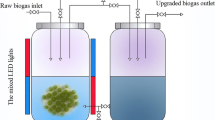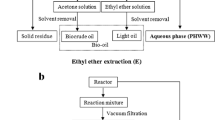Abstract
Algae symbiosis technology shows great potential in the synchronous treatment of biogas slurry and biogas, which has promising applications. For improving nutrients and CO2 removal rates, the present work constructed four microalgal systems: Chlorella vulgaris (C. vulgaris) monoculture, C. vulgaris—Bacillus licheniformis (B. licheniformis), C. vulgaris—activated sludge, and C. vulgaris—endophytic bacteria (S395-2) to simultaneously treat biogas as well as biogas slurry under GR24 and 5DS induction. Our results showed that the C. vulgaris—endophytic bacteria (S395-2) showed optimal growth performance along with photosynthetic activity under the introduction of GR24 (10−9 M). Under optimal conditions, CO2 removal efficiency form biogas, together with chemical oxygen demand, total phosphorus and total nitrogen removal efficiencies from biogas slurry reached 67.25 ± 6.71%, 81.75 ± 7.93%, 83.19 ± 8.32%, and 85.17 ± 8.26%, respectively. The addition of symbiotic bacteria isolated from microalgae can promote the growth of C. vulgaris, and the exogenous addition of GR24 and 5DS can strengthen the purification performance of the algae symbiosis to achieve the maximum removal of conventional pollutants and CO2.





Similar content being viewed by others
Data availability
The datasets generated during and/or analysed during the current study are available from the corresponding author on reasonable request.
References
Allen AE, Dupont CL, Oborník M et al (2011) Evolution and metabolic significance of the urea cycle in photosynthetic diatoms. Nature 473:203–207
Amin S (2009) Review on biofuel oil and gas production processes from microalgae. Energy Conv Manag 50:1834–1840
APHA (1995) Standard methods for the examination of water and wastewater. Washington, American Public Health Association
Bell W, Mitchell R (1972) Chemotactic and growth responses of marine bacteria to algal extracellular products. Biol Bull 143:265–277
Bhatt P, Bhandari G, Bhatt K et al (2022) Microalgae-based removal of pollutants from wastewaters: occurrence, toxicity and circular economy. Chemosphere 306:135576
Cao W, Wang X, Sun S, Hu C, Zhao Y (2017) Simultaneously upgrading biogas and purifying biogas slurry using cocultivation of Chlorella vulgaris and three different fungi under various mixed light wavelength and photoperiods. Bioresour Technol 241:701–709
Chinnasamy S, Ramakrishnan B, Bhatnagar A et al (2009) Biomass production potential of a wastewater alga Chlorella vulgaris ARC 1 under elevated levels of CO2 and temperature. Int J Mol Sci 10:518–532
Dong X, Wei J, Huang J et al (2022) Performance of different microalgae-fungi-bacteria co-culture technologies in photosynthetic and removal performance in response to various GR24 concentrations. Bioresour Technol 347:126428
Ferro L, Colombo M, Posadas E et al (2019) Elucidating the symbiotic interactions between a locally isolated microalga Chlorella vulgaris and its co-occurring bacterium Rhizobium sp. in synthetic municipal wastewater. J Appl Phycol 31:2299–2310
Giri DD, Dwivedi H, Khalaf DAA et al (2022) Sustainable production of algae-bacteria granular consortia based biological hydrogen: new insights. Bioresour Technol 352:127036
Ji X, Cheng J, Gong D et al (2018a) The effect of NaCl stress on photosynthetic efficiency and lipid production in freshwater microalga-scenedesmus obliquus XJ002. Sci Total Environ 633:593–599
Ji X, Jiang M, Zhang J et al (2018b) The interactions of algae–bacteria symbiotic system and its effects on nutrients removal from synthetic wastewater. Bioresour Technol 247:44–50
Jing X, Yang Y, Ai Z et al (2020) Potassium channel blocker inhibits the formation and electroactivity of Geobacter biofilm. Sci Total Environ 705:135796
Jun S-H, Yang J, Jeon H et al (2020) Stabilized and immobilized carbonic anhydrase on electrospun nanofibers for enzymatic CO2 conversion and utilization in expedited microalgal growth. Environ Sci Technol 54:1223–1231
Li X, Cai F, Luan T et al (2019) Pyrene metabolites by bacterium enhancing cell division of green alga Selenastrum capricornutum. Sci Total Environ 689:287–294
Li S, Li X, Ho S-H (2022) Microalgae as a solution of third world energy crisis for biofuels production from wastewater toward carbon neutrality: an updated review. Chemosphere 291:132863
Liu J, Wu Y, Wu C et al (2017) Advanced nutrient removal from surface water by a consortium of attached microalgae and bacteria: a review. Bioresour Technol 241:1127–1137
Mackay S, Gomes E, Holliger C et al (2015) Harvesting of Chlorella sorokiniana by co-culture with the filamentous fungus isaria fumosorosea: a potential sustainable feedstock for hydrothermal gasification. Bioresour Technol 185:353–361
Malapascua JRF, Jerez CG, Sergejevova M et al (2014) Photosynthesis monitoring to optimize growth of microalgal mass cultures: application of chlorophyll fluorescence techniques. Aquat Biol 22:123–140
Mennaa FZ, Arbib Z, Perales JA (2015) Urban wastewater treatment by seven species of microalgae and an algal bloom: biomass production, N and P removal kinetics and harvestability. Water Res 83:42–51
Mesbah M, Momeni M, Soroush E et al (2019) Theoretical study of CO2 separation from CO2/CH4 gaseous mixture using 2-methylpiperazine-promoted potassium carbonate through hollow fiber membrane contactor. J Environ Chem Eng. https://doi.org/10.1016/j.jece.2018.11.026
Qu W, Zhang C, Chen X et al (2021) New concept in swine wastewater treatment: development of a self-sustaining synergetic microalgae-bacteria symbiosis (ABS) system to achieve environmental sustainability. J Hazard Mater 418:126264
Shen X, Xue Z, Sun L et al (2020) Effect of GR24 concentrations on biogas upgrade and nutrient removal by microalgae-based technology. Bioresour Technol. https://doi.org/10.1016/j.biortech.2020.123563
Sial A, Zhang B, Zhang A et al (2021) Microalgal–bacterial synergistic interactions and their potential influence in wastewater treatment: a review. Bioenergy Res 14:723–738
Subashchandrabose SR, Ramakrishnan B, Megharaj M et al (2011) Consortia of cyanobacteria/microalgae and bacteria: biotechnological potential. Biotechnol Adv 29:896–907
Sun S, Ge Z, Zhao Y et al (2016) Performance of CO2 concentrations on nutrient removal and biogas upgrading by integrating microalgal strains cultivation with activated sludge. Energy 97:229–237
Tang Y, Song L, Ji X et al (2022) Algal-bacterial consortium mediated system offers effective removal of nitrogen nutrients and antibiotic resistance genes. Bioresour Technol 362:127874
Um B-H, Kim Y-S (2009) Review: a chance for Korea to advance algal-biodiesel technology. J Ind Eng Chem 15:1–7
Wang H, Tomasch J, Jarek M et al (2014) A dual-species co-cultivation system to study the interactions between Roseobacters and Dinoflagellates. Front Microbiol 5:311
Wang L, Addy M, Cobb K et al (2021) Interaction of Chlorella vulgaris and bacteria when co-cultivated in anaerobically digested swine manure. Bioresour Technol. https://doi.org/10.1016/j.biortech.2020.124250
Wang H, Wu P, Zheng D et al (2022) N-Acyl-homoserine lactone (AHL)-mediated microalgal–bacterial communication driving chlorella-activated sludge bacterial biofloc formation. Environ Sci Technol 56:12645–12655
Wang Z, Huang J, Zhao C et al (2023) Performance of different bacteria-microalgae-fungi consortium cultivation in nutrient removal and biogas upgrading by induction of GR24 and 5-deoxystrigol. J Clean Prod 392:136292
Xu M, Xue Z, Sun S et al (2020) Co-culturing microalgae with endophytic bacteria increases nutrient removal efficiency for biogas purification. Bioresour Technol 314:123766
Xu M, Ou D, Xue Z et al (2021) Enhancement of the photosynthetic and removal performance for microalgae-based technologies by co-culture strategy and strigolactone induction. Bioresour Technol 339:125579
Yang L, Li H, Wang Q (2019) A novel one-step method for oil-rich biomass production and harvesting by co-cultivating microalgae with filamentous fungi in molasses wastewater. Bioresour Technol 275:35–43
Zhang B, Li W, Guo Y et al (2020) Microalgal–bacterial consortia: from interspecies interactions to biotechnological applications. Renew Sustain Energy Rev 118:109563
Zhang H, Xu B, Zhao C et al (2022) Simultaneous biogas upgrading and biogas slurry treatment by different microalgae-based technologies under various strigolactone analog (GR24) concentrations. Bioresour Technol 351:127033
Zhao Y, Wang J, Zhang H et al (2013) Effects of various LED light wavelengths and intensities on microalgae-based simultaneous biogas upgrading and digestate nutrient reduction process. Bioresour Technol 136:461–468
Zhao R, Li X, Hu M et al (2017) Efficient enzymatic degradation used as pre-stage treatment for norfloxacin removal by activated sludge. Bioprocess Biosyst Eng 40:1261–1270
Funding
This research was supported by ABA Chemicals for funding support and the National Major Science and Technology Project (2017ZX07204-005).
Author information
Authors and Affiliations
Contributions
LS was in charge of investigation, drafting, reviewing and editing. JL was responsible for methodology, data management and interpretation. JX contributed to acquiring funding and analyzing formally. ZZ: contributed to acquiring funding and study conception.
Corresponding author
Ethics declarations
Competing interest
The authors declare no competing interests.
Informed consent
was obtained from all individual participants included in the study.
Consent for publication
The participant has consented to the submission of the case report to the journal.
Additional information
Publisher’s Note
Springer Nature remains neutral with regard to jurisdictional claims in published maps and institutional affiliations.
Supplementary information
Below is the link to the electronic supplementary material.
Rights and permissions
Springer Nature or its licensor (e.g. a society or other partner) holds exclusive rights to this article under a publishing agreement with the author(s) or other rightsholder(s); author self-archiving of the accepted manuscript version of this article is solely governed by the terms of such publishing agreement and applicable law.
About this article
Cite this article
Shu, L., Li, J., Xu, J. et al. Nutrient removal and biogas upgrade using co-cultivation of Chlorella vulgaris and three different bacteria under various GR24 concentrations by induction with 5-deoxystrigol. World J Microbiol Biotechnol 39, 245 (2023). https://doi.org/10.1007/s11274-023-03647-8
Received:
Accepted:
Published:
DOI: https://doi.org/10.1007/s11274-023-03647-8




